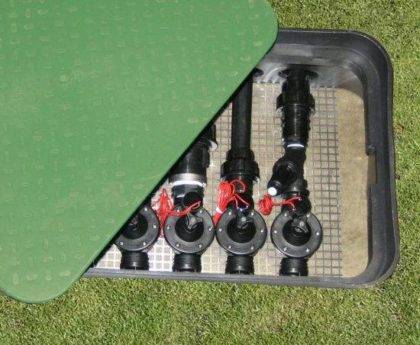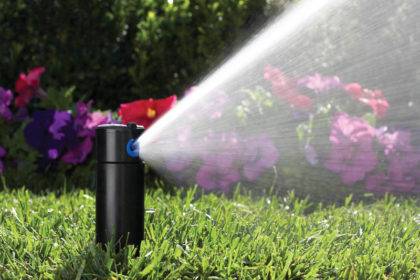Are you tired of watering your garden by hand during the long, hot summers? Are you fed up with your beloved plants dying and your lawn looking brown and bare? Do you want to take action but are unsure where to start? Then look no further – as here is a detailed introduction on setting up your very own, automated garden irrigation system.
The pump and tank pressure booster sets that we supply will form the ‘heart’ of your irrigation system. The all-inclusive submersible pump (positioned inside the tank) and tank unit will boost water pressure significantly, therefore being ideal for lawns that require watering with popup sprinklers. Additionally, by holding a buffer of water the irrigation system can operate for a limited period with flows that are substantially higher than your mains water flow. To protect the pump, in the event of the tank running out of water, the pump will stop running, periodically checking to see if the tank has refilled. Also, the built-in tank overflow ensures that the irrigation system is separated from the mains water supply, therefore ensuring full compliance with UK Water Regulations.
 Your garden will need to be split into separate, smaller watering zones, as watering your whole garden at once will not possible due to pressure and flow requirements. The pump is designed to automatically operate when it detects a drop in pressure, which occurs when each solenoid valve operating each zone opens. We supply underground solenoid valve boxes which house these solenoid valves (valves included). Being buried ensures that they are hidden from view, whilst also remaining easily accessible due to the top access lid. You can program the solenoid valves to open and close at the specified time and duration by a controller (the ‘brain’ of the irrigation system), which would normally be positioned on an external house/garage wall (connected to mains power) and be wired to the solenoid valves in the valve box using multi core signal cable. This cable would run underground, sharing a trench with the underground supply pipe running from the pump and tank, which would also run to the valve box. The underground supply pipe would then run from the valve box to each zone within your garden. For example, you could split your garden watering into 4 zones – zones 1 and 2 being popup sprinklers watering your lawn, zone 3 being dripline watering your flower borders, and zone 4 being dripline watering your hedges.
Your garden will need to be split into separate, smaller watering zones, as watering your whole garden at once will not possible due to pressure and flow requirements. The pump is designed to automatically operate when it detects a drop in pressure, which occurs when each solenoid valve operating each zone opens. We supply underground solenoid valve boxes which house these solenoid valves (valves included). Being buried ensures that they are hidden from view, whilst also remaining easily accessible due to the top access lid. You can program the solenoid valves to open and close at the specified time and duration by a controller (the ‘brain’ of the irrigation system), which would normally be positioned on an external house/garage wall (connected to mains power) and be wired to the solenoid valves in the valve box using multi core signal cable. This cable would run underground, sharing a trench with the underground supply pipe running from the pump and tank, which would also run to the valve box. The underground supply pipe would then run from the valve box to each zone within your garden. For example, you could split your garden watering into 4 zones – zones 1 and 2 being popup sprinklers watering your lawn, zone 3 being dripline watering your flower borders, and zone 4 being dripline watering your hedges.
 For watering lawn areas we use the Hunter PGP Ultra popup sprinkler – this has a large range of nozzle settings, so its watering radius can be altered – ensuring that lawns of all sizes receive complete water coverage. This sprinkler also features an adjustable arc ranging from 50 to 360 degrees, again ensuring that all areas of the lawn receive complete coverage – e.g., on a long, wide rectangular lawn, sprinklers could be set at 90 degrees in the corner, 360 degrees in the centre (full circle) and 180 degrees at the sides. If your lawn is unusually shaped, you’ll find that this adjustable arc is very useful!
For watering lawn areas we use the Hunter PGP Ultra popup sprinkler – this has a large range of nozzle settings, so its watering radius can be altered – ensuring that lawns of all sizes receive complete water coverage. This sprinkler also features an adjustable arc ranging from 50 to 360 degrees, again ensuring that all areas of the lawn receive complete coverage – e.g., on a long, wide rectangular lawn, sprinklers could be set at 90 degrees in the corner, 360 degrees in the centre (full circle) and 180 degrees at the sides. If your lawn is unusually shaped, you’ll find that this adjustable arc is very useful!
For watering flower borders and hedges we use Permadrip Pro dripline, as dripline is very efficient due to no water being lost by hitting the plants (if using sprinklers) – with the water from each built-in dripper travelling straight down to the roots. Drippers are spaced every 0.5m along the dripline for border dripline and every 0.3m for hedge dripline – for this reason flower borders and hedges will need to be zoned separately. As the dripline we supply is pressure compensated, every single dripper will emit the same amount of water (uniform output – 1.6 litres per hour), ensuring that the whole flower border/hedge is watered evenly. Each dripper is also self-flushing to reduce blockages.
So, now that you’ve been introduced to the general set-up of an automated garden irrigation system, you’ll hopefully be able to turn your dream of a well-watered, green and flourishing garden into a reality!